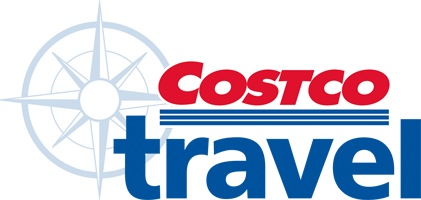
South Pacific: Pristine Australian Wilderness Voyage
Regent Seven Seas Cruises
You can admire spectacular views of one of the world's most famous opera houses from your balcony, Australia is a singular experience unlike any other on the planet. The fascinating wildlife, the bare beauty of the outback, the vibrant and wild wetlands and seas teeming with life make this cruise unforgettable.

All onboard gratuities
Select complimentary shore excursions**
Unlimited beverages, including fine wines and premium spirits served throughout the ship
In-suite refrigerator replenished daily with soft drinks, beer and bottled water
24-Hour room service
No charge for specialty restaurants
Welcome bottle of Champagne
$100 Shipboard credit (per suite)††
Executive Member Benefit
Executive Members receive an annual 2% Reward, up to $1,000, on qualified Costco Travel purchases
Executive Members receive an additional $100 shipboard credit (per suite, not combinable with certain past-guest discounts)††
Digital Costco Shop Card
Member Exclusive: Digital Costco Shop Card with every Regent Seven Seas Cruises® sailing†
Sailing Itinerary

Note: Cruise itineraries are subject to change. Please verify ports and times directly with the cruise line.
Overview
Though physically small, Singapore is an economic giant. It has been Southeast Asia's most modern city for over a century. The city blends Malay, Chinese, Arab, Indian and English cultures and religions. Its unique ethnic tapestry affords visitors a wide array of sightseeing and culinary opportunities from which to choose. A full calendar of traditional festivals and holidays celebrated throughout the year adds to its cultural appeal. In addition, Singapore offers luxury hotels, delectable cuisine and great shopping! Located at the tip of the Malay Peninsula, Singapore's tropical climate welcomes both leisure and business travelers year round. The island republic's excellent infrastructure enables visitors to enjoy its many sites and attractions in a safe, clean and green environment. Award winning Changi Airport provides airlinks to major cities around the world. The train and subway systems are clean, fast and efficient. In addition, its state-of-the-art cruise terminal has established Singapore as one of the premier cruising centers of South East Asia and an exciting port of call on any Asian cruise itinerary. In the city, there is no need for a car. Public transportation is excellent and walking is a good way to explore the city . All major attractions are also accessible by tour bus. Since the city is only 60 miles (100k) from the equator, the tropical temperatures do not vary much. Rainfall is fairly evenly distributed through the year. No matter when you choose to visit, warm weather will be abundantly available. The visitor is struck immediately by Singapore's abundance of parks, nature reserves, and lush, tropical greenery. Singapore's progress over the past three decades has been remarkable, yet the island has not been overwhelmed by development. Visitors will discover a wealth of historical treasures from the past, in the beauty of older buildings, values and traditions that have survived in the face of profound social and geographical change. Lacking any noteworthy natural resources, Singapore's early prosperity was based on a vigorous free trade policy, put in place in 1819 when Sir Stamford Raffles first established it as a British trading post. Later, mass industrialization bolstered the economy, and today the state boasts the world's second busiest port after Rotterdam, minimal unemployment, and a super efficient infrastructure. Almost the entire population lives in upscale new apartments, and the average per capita income is over US$12,000. Singapore is a clean, safe place to visit, its amenities are second to none and its public places are smoke-free and hygienic. Forming the core of downtown Singapore is the Colonial District. Each surrounding enclave has its own distinct flavor, from the aromatic spice stores of Little India, to the tumbledown backstreets of Chinatown, where it is still possible to find calligraphers and fortune tellers, or the Arab Quarter, whose cluttered stores sell fine cloths and silks. North of the city, are two nature preserves, Bukit Timah and the Central Catchment Area, along with the splendid Singapore Zoological Gardens. The east coast features good seafood restaurants set on long stretches of sandy beach. In addition there are over fifty islands and islets within Singaporean waters, all of which can be reached with varying degrees of ease. Day trips are popular to Sentosa, the island amusement arcade which is linked to the south coast by a short causeway and cable car. Music, theater, nightlife: all are abundant in this remarkable city. Singapore used to be considered a "stop over" on the way to larger Asian cities. This is no longer true! Visitors seek out Singapore for business and finance and also for a fascinating and satisfying vacation for the whole family. Strategically located at the southern tip of the Malay Peninsula sixty miles from the equator, Singapore has for centuries been a crossroads between East and West. Chinese traders en route to India had navigated its waters from at least the 5th century. In the 14th century it was part of the powerful Vijayan Empire and was known as Tenmasek or Sea Town. Legend has it that it was renamed Singa Pura or Lion City after a visiting Sumatran prince saw an animal he mistook for a lion, an animal considered a good omen. Modern Singapore came into being in 1819 when Sir Stamford Raffles claimed what was then a small fishing village as a regional base for the East India Company. The island's natural harbor and location made it an ideal site for a trading post serving British trade interests between China, the Malay world and India. Singapore flourished as its free trade policy attracted merchants and residents from all over the world. Raffles initiated a town plan which included leveling one hill to form a new commercial district (now Raffles Place) and constructing government buildings around another hill (now called Fort Canning Hill). The British plan also involved separating the population according to ethnic categories with Europeans, Indians, Chinese and Malays each living and working in their own distinct quarters of the city. Revenues soared in ensuing years from the production of opium and rubber. Millionaires were made overnight. Immigration rose steadily. The island became Britain's strategic defense base in the Far East but fell to the Japanese in 1942. After the world war ended in 1945, Singapore became a crown colony. It gained self governing status in 1959 and independence in 1965 when it became part of the new state of Malaysia which united Malaya with Singapore, Sabah, and Sarawak. The alliance did not last. Singapore was used to being on its own, and within two years the island set up its own stable government and became known as the Republic of Singapore. Under Prime Minister Lee Kuan Yew's leadership, Singapore continued to strengthen its infrastructure and its industrial base. Housing and urban renovation kept pace with population growth. The areas of health and education are strong. Singapore's leaders have also brought order and progress through strict regulation of social behavior. Smoking in public was banned, as was gum chewing. High economic growth rates have supported political stability. Singapore is the world's second busiest seaport, has an airport served by over 50 major airlines. It has state of the art communication and mass transit systems. It is Asia's premier center for finance and business and the world's third largest oil refining center. Over 7 million visit the tiny island every year.
Overview
Semarang is a port city on the north coast of Java, Indonesia. Its old quarter features Dutch colonial architecture including the landmark Lawang Sewu, a massive building that was the railway company's headquarters. Sam Poo Kong, a 15th-century temple, is a prominent site in Chinatown. The modern city centers around Simpang Lima, a tree-lined green space in the commercial district.
Overview
Surabaya is a port city on the Indonesian island of Java. A vibrant, sprawling metropolis, it mixes modern skyscrapers with canals and buildings from its Dutch colonial past. It has a thriving Chinatown and an Arab Quarter whose Ampel Mosque dates to the 15th century. The Tugu Pahlawan (Heroes Monument) honors the independence battles waged in Surabaya’s streets in 1945.
Overview
Benoa is the most important port and commercial port of Bali for some 10 km away, the Denpasar. After the conquest of the island by the Dutch was the port (Labuhan Benoa) artificially created. Swimming is a wonderful fishing village of the neighboring Tanjung Benoa, on which you can translate.
Overview
Benoa is the most important port and commercial port of Bali for some 10 km away, the Denpasar. After the conquest of the island by the Dutch was the port (Labuhan Benoa) artificially created. Swimming is a wonderful fishing village of the neighboring Tanjung Benoa, on which you can translate.
Overview
Komodo island, part of the Lesser Sunda chain of Indonesian islands, is the rugged habitat of the 3m-long Komodo dragon monitor lizard. Komodo National Park covers the entire region and is home to more than 4,000 dragons, and is made up of rusty-red volcanic hills, savannah and forests. Its surrounding waters of seagrass beds, mangrove shrublands and coral reefs are famous for diving.
Overview
Darwin - Capital City of the Northern Territory Where Asia meets the Dreamtime An exciting, eclectic mixture of cultures A place that is truly uniquely Australian while being home for more than 60 different nationalities, people who come from all continents of the globe. A focus for festivals, food and fashion. A sporting centre, home to the Darwin Cup, the Arafura Games and more and more exciting national and international sporting events Darwin City - Set on a rocky peninsula reaching into one of the most beautiful natural harbours on the north Australian coast. Elevated above the cliffs, surrounded by water on three sides, a city fanned by soft cool breezes that contribute to its tropical charm. The tropical climate encourages outdoor living and locals and visitors alike take advantage of this lifestyle to stroll through Darwin's leafy streets, browsing through the art galleries and enjoying cafe life, discovering little hidden corners of the city. The contrasts are exquisite. A Chinese temple with its statues of the Immortals, the smoke from incense drifting slowly upward, lies only twenty metres behind busy Cavenagh St, but exists in a different world, timeless and peaceful. Darwin - a city of contrasts and tempting tastes. where shady parks suitable for quiet contemplation lie only metres from streets full of shoppers, the smells of food drift on the air from sizzling grills, flaming woks and bubbling saucepans. Darwin - take time to enjoy its wonderful trees that surprise our visitors, exotic flowering trees, frangipani, Pride of India and poincianas, the shady raintrees, banyan and tamarind trees delight the senses and leave images of a truly tropical city. Darwin - A city destroyed three times - first by the cyclone of 1893, then by the bombs of World War II, next by Cyclone Tracy. The spirit of survival undiminished, Darwin has grown and developed to become the modern city of today, a monument to the tenacity and courage of its people.
Overview
Cooktown is a small town at the base of Cape York, Queensland, Australia. It was first colonised by Captain Cook in 1770 after his ship, HMS Endeavour ran aground on a nearby coral reef. The crew were able to get the ship into our Endeavour River for repairs. The colonisation took the form of their six weeks stay. Nothing much happened after this for about 100 years until gold was discovered in the Palmer River near Cooktown. The population of Australian, Chinese and many other nationalities surged to near 5000. There were 100 hotels and many other businesses necessary to support the new population of mostly adventurers and gold seekers. By the late 1880s, 60 tons of gold had been won and the gold rush was over. During this period, Cooktown was the third largest port in Queensland. The population started to diminish, helped by disastrous cyclones in 1907 and 1949 and a large fire in 1919. The first world war and the 1930-8 depression also played their part. Stability came in the 1950s and the small population has continued to grow and prosper with better roads and airservices. Cooktown still has a largely "historic town" nature and this adds to its interests for tourists. As well, the majority of the population prefer it to be a quiet country-style township. However, with the road to Cooktown getting close to being fully sealed, and with close to 100,000 tourists passing through each year, it is only a matter of time before we are dragged, kicking and screaming, into the 21st century.
Overview
Yorkeys Knob is the most central beach of Cairns Northern Beaches located right in between Cairns and Palm Cove. Yorkeys Knob is a great beach for adventure enthusiasts and active travellers who want to escape the tourist-dense hotspots associated with many other beaches around Cairns.
Overview
Townsville, in North Queensland is Australia's largest tropical city. It has an urban population of 130,000 and is renowned for its magnificent climate, consistantly recording more than 300 dry sunny days each year. The city is a charming blend of old and new, with a rich history and surprising cultural depth. It has many well preserved civic commercial and domestic buidings dating back to the region's European settlement in the late 19th century. Townsville offers easy access to many attractions, to the Great Barrier Reef and World Heritage rainforests, together with islands that range from the uninhabited to those with world class resorts. The wonderfully authentic goldfish city of Charters Towers is just 90 minutes easy drive from Townsville and is a virtual ''time capsule''of Victorian, Edwardian and Australian colonial architecture. It also marks the start of the Aussie Outback, with it's unique native animals and herds of free ranging cattle. Townsville is the ''real'' Australia - with a relaxed, friendly lifestyle that offers a warm greeting to visitors. It also offers a diversity of experience that range from the excitement of the Breakwater Casino and the worlds largest living reef aquarium, through to the natural beauty of Magnetic Island and some of the worlds best marlin fishing and scuba diving.
Overview
Airlie Beach is a coastal locality in the Whitsunday Region of Queensland, Australia. In the 2016 census, Airlie Beach had a population of 1,208 people.
Overview
Newcastle, New South Wales, is Australia's 6th largest city and an important port. The city is located about 160 kilometres north of Sydney. Despite the city's coal-mining and industrial heritage it has plenty of interesting sights to offer, not the least being the convict ruins and fine Victorian architecture. The city's fine white sandy beaches are regarded as some of the finest in Australia, not to mention Hawaii to where Newcastle sends most of the sand exported each year. By-the-way the surfing is pretty good too, as Mark Richards, one of Australia's finest surfers can testify. As most coal-mining in Newcastle was underground, a legacy of the coal mining companies are the large areas of eucalyptus forested hills which provide a wonderful green backdrop to the many vistas. One of the finest is the view west as the sun sets behind Mount Sugarloaf. Newcastle's very hilly terrain also provides many people in the suburbs with fine views of the coastline and out to sea where many coal carriers await their turn for loading. The coal export capacity of the port makes it one of the larger coal ports in the world now, but with its continuing and rapid expansion will one day be the world's largest. Prior to the city's founding, the area was occupied by the local Koori tribes. The Hunter River and surrounding estuarine waters of Lake Macquarie and Fullerton Cove were rich with marine-life. These tribes apparently had a very intricate trading network with inland tribes. The mouth of the Hunter River by which the present day city of Newcastle is sited, was discovered in 1797 by Lieutenant John Shortland RN. After the discovery of coal in 1799, a settlement was founded in 1801 as a penal colony, however this was abandoned in 1802. In March 1804, Lieutenant Charles Menzies arrived at the mouth of the Hunter River to re-establish the settlement. This was named Newcastle by Governor King, but for many years until around 1830, the settlement was known as "King's Town". The convicts principally mined coal, but also cut timber and burnt lime to supply the growing Sydney Town to the south. Newcastle gained a reputation for being one of the most brutal outposts of the convict system. As more free settlers moved into the Hunter Valley from 1820 onwards, most of the convicts were removed allowing Newcastle to be declared a free town in 1824. Despite the status of Newcastle as a free town, the growth in the population remained very slow. In the years leading up to the 1850s the Australian Agricultural Company held a monopoly of the town's coal production. Convicts were the initial workforce, but due to their lack of mining skills and laziness, even under the harsh conditions, the company sought free settlers from overseas to mine the coal. Thus the new immigrants to Newcastle mainly consisted of Welsh and Cornish people. After 1847 other coal companies were allowed to mine Newcastle's coal. This was also the year that according to the Hunter Valley Research Foundation, Newcastle was proclaimed a City. It was also during 1847, that the Anglican Diocese of Newcastle was founded by Royal Letters Patent. The initial boundaries of the new See were defined: From the Hawkesbury River in the South, to the 21st Parallel of Latitude on the North, and from the Pacific on the East, to the boundary of South Australia - the 141st degree of Longitude - on the West. This area has subsequently been diminished through the creation of new Dioceses. On the 29th June, St. Peter's Day, of 1847, the Reverend William Tyrrell was consecrated in Westminster Abbey as the first Bishop of Newcastle and on the 30th January of the following year (Dr. Tyrrell's 41st birthday) he was installed in the Cathedral at Newcastle. For more information about the Anglican Diocese of Newcastle and its history, visit here. There were apparently still many Koori people living in the area until the 1850s. Disease, famine and marginalisation by the new settlers brought about their ultimate demise and therefore disappearance from the area. Before the monopoly of the Australian Agricultural Company was curtailed, the town's growth was very slow. By 1856 there were still only 1,534 people. With the influx of the new coal companies and the migrants to work for them, Newcastle's population began to rapidly grow so that by 1880 it was larger than Hobart, the Capital of Tasmania. Like many other areas in Australia the city suffered greatly in the depression of the 1890s. It was not until the advent of World War I, and the establishment of the BHP Steelworks in 1915, did Newcastle recover. Newcastle was a major industrial city of Australia during the 1930s through to the 1980s. Many smaller allied industries to the Steelworks were swallowed by the growing giant of BHP, which has since become a transnational company, as the steelmaking process was streamlined throughout the 1930s to the 1950s. The 1960s saw the zenith of the plant, with its capacity being the highest in the world. Rationalisation of industry in Australia in the 1980s saw the loss of many manufacturing jobs, particularly those allied with steelmaking. The city has increasingly become a service centre with the majority of jobs now in the tertiary sector. Newcastle now has a population of over 300,000 people and overall services a population of 500,000 people who reside in the Hunter Valley Region of New South Wales. The major employment areas for the population now lie in the health and education areas. Still with a heavy emphasis on its manufacturing institutions however, Newcastle was dealt a massive blow on 29th April, 1997. It was announced on that day that BHP would close the Steelworks. This resulted in the loss of 2,500 workers over the next three years, and the potential loss of 8,000 more jobs in allied industries. Was this the death blow though? Well as the tertiary sector now employs most working people, this did not have as great an impact as first thought. Newcastle is now reinventing itself, finding new ways to employ people. One up side of the closure of the BHP Steelworks has been the increased cleanliness of the city, drawing in many people to visit and also to move permanently to Newcastle. The city has many fine institutions, the largest being the University of Newcastle. Newcastle has many other sights and events worth a visit. There are Jazz festivals, Show week and the Mattara festival which form just a few of the important events in the cultural life of Newcastle. The city has a vibrant nightlife: fine restaurants, theatres for movies and plays, concert halls, and nightclubs. The city's citizens (called Novocastrians) are also very proud of their sporting deeds. Every weekend you can see Mums and Dads urging their children to play faster and harder. With their strong working-class ethic and fierce loyalty, Novocastrians always provide good support for their sporting teams, no matter what the game. And no matter what the game, all visiting teams fear playing Newcastle on its home turf. This though is only the surface of a typical Novocastrian. If you are lost or waylaid there are plenty of kind hearted citizens to help you out. In many ways Newcastle is really just a big country town. In 1997, Novocastrians celebrated the bicentenary of the European discovery of Newcastle and its harbour.
Overview
Sydney is Australia's largest and most cosmopolitan city and is the capital of New South Wales, the most heavily populated state of Australia. Sydney is situated on one of the world's most beautiful and famous harbours. Sydney also boasts beautiful beaches, fantastic shops, restaurants, history and culture. Sydney's many highlights include the Harbour Bridge, the Opera House, Centrepoint Tower, The Rocks, the stunning harbour and the white sands of Bondi, Manly and beyond. Sydney is also home to beautiful National Parks, the Royal Botanic Gardens, many harbour front picnic locations and heritage areas.
Onboard the Seven Seas Voyager
Seven Seas Voyager
Year Built: 2003
Year Refurbished: 2016
Double Occupancy Capacity: 700
A trailblazer in the exclusive world of all-suite, all-balcony ships, Seven Seas Voyager® exceeds even the loftiest expectations for luxury. Considering her size, the amenities are surprisingly plentiful and include four main dining venues where you can dine wherever, whenever and with whomever you choose. With 447 international crew members attending to a maximum 700 guests, personal service is exceedingly indulgent throughout.
Activities & Services (included in cruise)
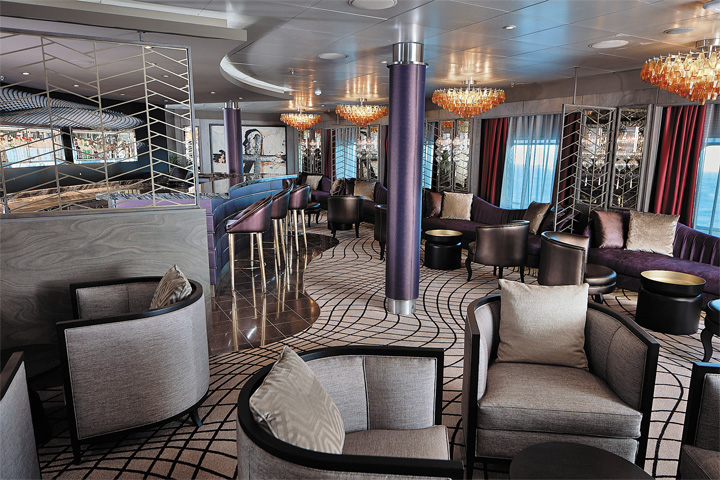
Fitness Center
- Card Room
- Disco/Nightclub
- Movies
- Fitness Center
- Sauna/Steam Room
- Educational Programs
- Pool - Outdoor
- Sports Facilities
- Whirlpool/Jacuzzi
- Bars/Lounges
- Library
- Wi-Fi
- Organized Age Specific Activities
- Teen Programs
- Business Center
- Concierge Desk
- Dry Cleaning/ Laundry Service
- Duty-Free Shops/Boutiques
- Elevators
Activities & Services (available for an extra fee)
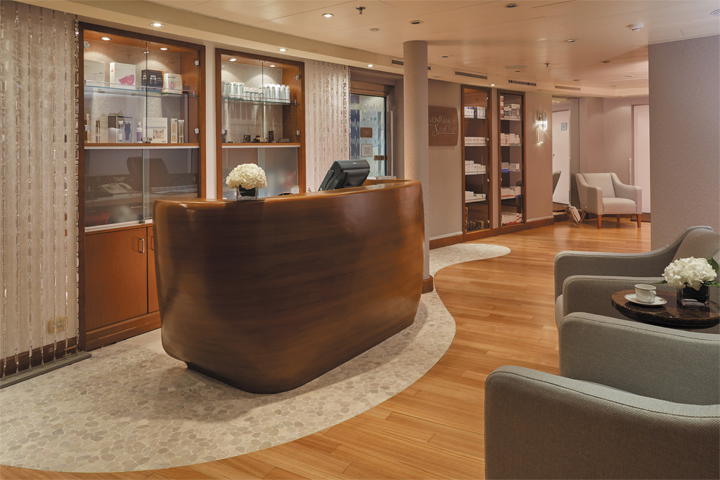
Full-Service Spa
- Beauty Salon
- Full-Service Spa
- Infirmary/Medical Center
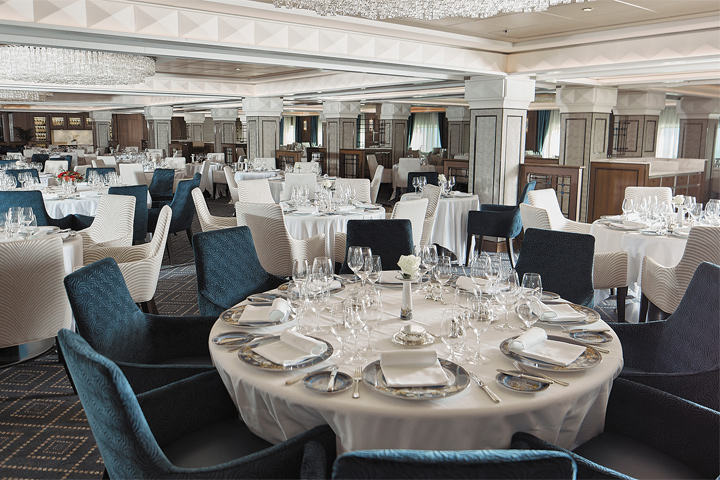
Compass Rose
Specialty Dining
Chartreuse: Featuring a classic French menu with a modern twist, Chartreuse evokes memories of a chic Parisian fine dining restaurant discovered during an evening stroll. Wherever you are seated in this regal restaurant, you will be treated to a succulent dinner while enjoying incredible ocean views. The restaurant ambiance is complemented by a menu that features dishes expertly prepared using both classic and modern techniques for a multiple course celebration of French gastronomy.
Compass Rose: Much thought was given to the design of Compass Rose, the flagship restaurant of Regent Seven Seas fleet. The dining room is outfitted with rich woods contrasted by light marble stones and mother of pearl shimmering brightly with an elegant color theme of light shades of blue, white, gold and silver. Compass Rose delights with a beautifully defined atmosphere and transitions from refreshing natural light during the day to a romantic ice blue lighting theme at night. This is the perfect setting for you to enjoy your breakfast, lunch and dinner, where the menu features an exceptional variety of Continental cuisine.
Prime 7: A true classic in every sense, Prime 7 sets a new standard in steakhouse fare with its contemporary interpretation of an American favorite. Handsomely decorated with supple leather wing-back chairs, burnished woods and rich earth-toned fabrics, Prime 7 exudes a distinct, intimate elegance. All the traditional starters are here, including Jumbo Lump Crab Cakes, Classic Steak Tartare, and Clam Chowder. Of course, beef is the undisputed star, and it is all USDA Prime and Dry-Aged at least 28 days to ensure the ultimate tenderness, juiciness and flavor. Prime New York Strip, Porterhouse Steak and succulent Filet Mignon only touch upon the selections. Mouthwatering alternatives include Alaskan King Crab Legs and Dover Sole. Prime 7 is open for dinner only and reservations are required.
Sette Mari at La Veranda: Each evening, La Veranda transforms into Sette Mari at La Veranda, a casual, intimate dining experience. Enjoy an extensive menu of authentic antipasti and Italian specialties served á la carte and paired with fine Italian wines — complimentary of course. Delectable dishes are prepared á la minute by talented chefs using only the freshest gourmet ingredients and served by attentive waiters. Sette Mari at La Veranda is open for dinner only.
Casual Dining
La Veranda Restaurant: Take in stunning ocean views while enjoying elegant breakfast and lunch buffets in the chic indoor dining room or al fresco on the shaded, open-air deck. Breakfasts include traditional favorites, as well as a made-to-order omelet station, a variety of fresh fruits and pastries, along with daily specials, like fluffy Belgian waffles with fresh blueberry compote. For lunch indulge in an array of choices from a bountiful salad bar, gourmet sandwiches, hot carving stations and delicious desserts.
Pool Grill: The Pool Grill is open-air, yet abundantly shaded for comfortable dining. Enjoy grilled-to-order burgers, grilled seafood, sandwiches, and fresh salads. Treat yourself to milkshakes and malts or an old-fashioned hand-dipped ice cream dessert sprinkled with all your favorite toppings.
Room Service: Complimentary 24-hour dining in the comfort of your stateroom.
Features a European king-size bed, a sitting area, a marble bathroom, a walk-in closet and a balcony. Concierge Level is available.

Category: H
356 sq.ft.; 306 sq.ft.; Balcony: 50 sq.ft.

Category: G
356 sq.ft.; 306 sq.ft.; Balcony: 50 sq.ft.

Category: F
356 sq.ft.; 306 sq.ft.; Balcony: 50 sq.ft.
Spacious suites feature an in-suite iPad, daily canapés and upgraded bathroom amenities.

Category: A
Penthouse Suites include Butler Service; 370 sq.ft.; 320 sq.ft.; Balcony: 50 sq.ft.

Category: B
Penthouse Suites include Butler Service; 370 sq.ft.; 320 sq.ft.; Balcony: 50 sq.ft.

Category: C
386 sq.ft.; 306 sq.ft.; Balcony: 115-198 sq.ft.
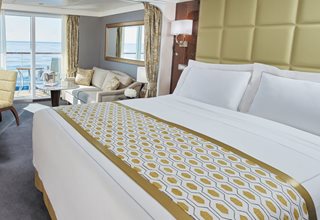
Category: D
356 sq.ft.; 306 sq.ft.; Balcony: 50 sq.ft.

Category: E
356 sq.ft.; 306 sq.ft.; Balcony: 50 sq.ft.
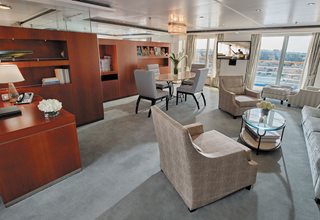
Category: MS
2 bedrooms; Master Suites include Butler Service; 1335 sq.ft.; 1152 sq.ft.; Balcony: 183 sq.ft.
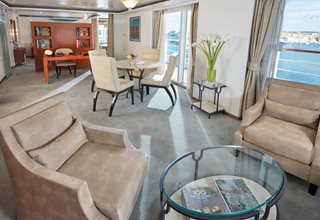
Category: GS
Butler service; 876 sq.ft.; 753 sq.ft.; Balcony: 123 sq.ft.

Category: VS
Voyager Suites include butler service; 604 sq.ft.; 554 sq.ft.; Balcony: 50 sq.ft.
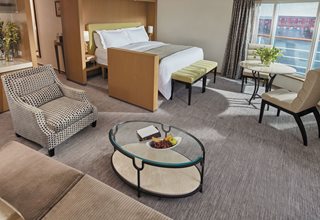
Category: SS
Seven Seas Suites include Butler Service; 545 sq.ft.; 495 sq.ft.; Balcony: 50 sq.ft.

| Symbol | Description |
|---|---|
 | Three guest capacity suite, convertible sofa bed |
 | Wheelchair accessible suites have shower stall instead of bathtub |
 | Connecting suites |
 | 2-bedroom suite accommodates up to 6 guests |
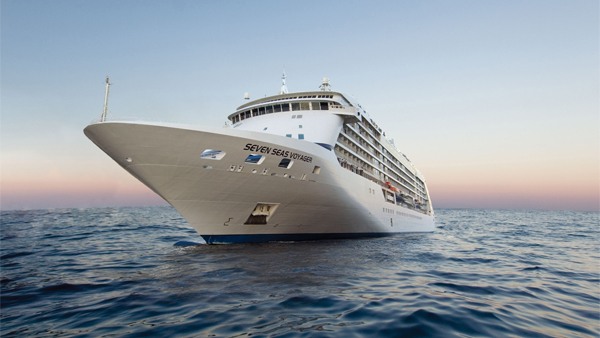
- Ship Name: Seven Seas Voyager
- Year Built: 2003
- Year Refurbished: 2016
- Year Entered Present Fleet: 2008
- Ship Class: Mariner
- Maximum Capacity: 700
- Number of Passenger Decks: 9
- Number of Crew: 447
- Officers' Nationality: International
- Tonnage (GRT): 42,363
- Capacity Based on Double Occupancy: 700
- Country of Registry: The Bahamas
- Total Staterooms: 350
- Suites with Balcony: 350
- Crew/Hotel Staff Nationality: European/International
Available Dates & Prices
Terms & Conditions
*Price shown is per person based on double occupancy, is valid for select stateroom categories only, and does include government taxes/fees and gratuities. Click on the Terms & Conditions link below for details.
**Select complimentary shore excursions are for full-fare guests only, capacity controlled and subject to availability. Shore excursion reservations are accepted on a first-come, first-served basis. Please note, available excursions vary by sailing date and day of the week. Government fees and taxes are included. Requested excursions may not be available at time of booking. Supplement will apply on Regent Choice excursions and excludes Private Arrangements and all Adventures Ashore programs. Restrictions apply and penalties apply 36 hours prior to shore excursion start date.
††All shipboard credit is in U.S. dollars, is per stateroom based on double occupancy, has no cash value, is nontransferable and not redeemable for cash.
†One Digital Costco Shop Card per room/stateroom, per stay. The exact amount of the Digital Costco Shop Card will be calculated during the booking process. The Digital Costco Shop Card promotion is nontransferable and may not be combined with any other promotion. A Digital Costco Shop Card will arrive by email approximately 10 days after the start of your cruise. Click on the Terms & Conditions link below for additional information.
Ship's registry: The Bahamas
Digital Costco Shop Card
This booking includes a Digital Costco Shop Card which will arrive by email one to two weeks after you return from your vacation. The Digital Costco Shop Card is a convenient payment option in our warehouses and on Costco.com.

